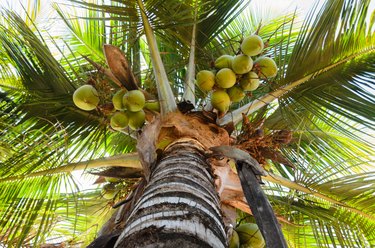
Growing as a perennial in the sub-tropical climates of U.S. Department of Agriculture plant hardiness zones 10 through 12, the coconut palm (Cocos nucifera) dramatically rises to a potential height of 100 feet. Only residents of south Florida, south Texas and Hawaii can successfully grow this plant. If you live elsewhere, you'll have to travel to these locations to see it growing and producing coconut fruits.
Coconut palm is a long-lived tree that often lives to the ripe old age of 90. Although it won't start bearing fruit until six to 10 years after it germinates and it won't hit its optimal production stride until it's 15 to 20 years old, a healthy coconut palm typically continues to produce fruit until it's around 80 years old. Depending on a tree's age, climate and cultural conditions, plants produce from 50 to 200 coconuts each year.
Video of the Day
Video of the Day
Tip
Under optimal growing conditions, a coconut palm tree grows at the rate of 12 to 36 inches per year, according to Cal Poly Urban Forest Ecosystems Institute.
Uses of the Coconut Palm
Coconut palm is perhaps the plant with the most usefulness to people. Although its fruit may be the first product that comes to mind for its meat, milk and oil, even the husk and protective shell around the fruits are useful. Husk fibers, called coir, are used to make plant potting media, ropes and nets, and coconut shells are used for fuel. The long trunks are used to make huts, canoes and even small bridges.
Coconut Palm Tree Growth Rate
Because coconut palm has a growth rate that ranges from 12 to 36 inches a year, commercial growers certainly have an economic imperative to optimize plant health and maximize the growth rate potential. Even backyard growers who simply want to grow their own coconuts have an incentive to keep their plants in the peak of health. Carefully tended coconut palms grow faster and produce fruit quicker than neglected plants.
Coconut Palm Tree Culture
A characteristic tropical environment provides the optimal growing conditions for growing coconut trees. This plant prospers in frost-free locations where it receives full sun and high humidity. It grows best on fertile soils that are moist but well-draining. Not surprisingly, since you'll see these plants growing along shorelines, coconut palm is tolerant of salt and wind.
Coconut palm not only flourishes in daily full sun but its annual requirement is more than 2,000 hours of sunlight. Healthy growth also depends on an average daily temperature that's not less than 72 degrees Fahrenheit and at least 30 to 50 inches of rainfall each year. Even at 40 degrees, which is well above freezing, a coconut palm's leaves may be damaged, and if temperatures dip below freezing (32 degrees), a coconut palm's trunk may be permanently damaged, which impairs its rate of growth.
Cold damage may be minimized in trees that are properly fertilized. Because a coconut palm's health and growth rate may be severely compromised due to nutritional deficiencies, particularly from insufficient nitrogen, potassium and magnesium, using a product that's specially formulated as palm fertilizer is recommended. Although product-specific label directions vary, you may need to apply fertilizer around your coconut palm every two to three months.